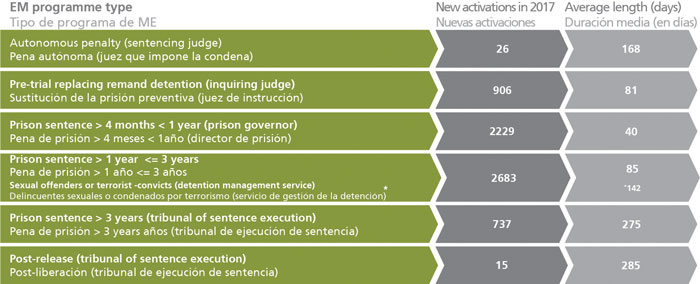
Electronic monitoring and the future
What do we talk about when we talk about “electronic monitoring” (EM)? We talk about the future. Not simply about what it would mean to adopt this or that EM technology now, whose interests are served or threatened (although that figures too), but what problems it will solve or create in the decades to come.
Visions of possible, probable and preferable futures have been inscribed in all conversations about EM, whether from technical, commercial, political and professional standpoints, since its prototypes first appeared in the 1960s and, even more so, since it became an operational reality in the US, and then around the western world, in the 1980s and 90s.
As with all novel technologies, the various scenarios have been both utopian and dystopian, with a fair amount of cautious pragmatic acceptance in between.
The claim that widespread adoption of location monitoring technologies, in isolation or more likely in combination with other community sanctions, would become the means of reducing or even abolishing imprisonment has surfaced with each qualitative technical “improvement” (the upgrade from RF to GPS being, until recently, the last occasion).
Yet nowhere has EM actually been a fully “disruptive innovation”, for better or worse, least of all in the US where it originated, where a punitive, prison-centric culture has both limited the scale of its development and shaped it in punitive, prison-mimicking ways. European use of EM has been more versatile – punitive, protective and supportive of rehabilitative measures – and, proportionately, in some countries, on a larger scale than in the US.
Most European EM, whether RF or GPS, is embedded in probation – or other statutory – agencies, precariously subordinate to its humanistic ethos, although the health of that ethos is perennially in contention. Arguments about the possible stigma of the ankle bracelet, about when and how best to integrate location monitoring, at what intensity and for what duration, into rehabilitative and reintegrative services have not been settled everywhere.
Against a backcloth of anxiety about a more generally surveillant future, there is nonetheless widespread acceptance that some forms of EM can be useful, and sufficient evidence from research to inform good practice – which may or may not be acted upon.
One problem is that EM is not a static, merely geolocational, technology – alcohol monitoring has extended its range (and meaning) to encompass direct monitoring of drinking behaviour, based on the detection and measurement of biochemical traces.
Smartphones, and a range of specialist apps which further combine location and somatic monitoring, and add a dialogical element to the process, are being pressed into the service of monitoring low-risk offenders.
These developments are the consequence of EM companies aligning themselves with the “corporate futurism” – convivial connectivity for all – promoted by Silicon Valley; discursively, at least, they associate EM less with specifically penal cultures and practices and more with the emerging world of “computable bodies”, “quantified selves”, Smart Cities and the Internet of Things. “Imagine”, says Nir Shelly, an industry insider, just a few years ahead:
Electronic monitoring is no longer based on the electronic bracelets, but, rather, on a cutting-edge no-tag, self-installing solution that seamlessly interfaces with a user-friendly and flexible application that can be managed on the move. The EM programs manage all the stages of offender’s rehabilitation from in-facility tracking to location-based tracking outdoors. The EM solutions become so advanced, in fact, that now you not only can monitor offender’s whereabouts, but also health, levels of stress and mood, amounts of daily physical activity, calories consumed and burnt and much more. It is very clear how cost-and-socially-effective EM programs are, and they become part of a golden standard for rehabilitating prisoners, adopted by almost all the governments of the world.
(Shelly 2016)
Outside the Silicon Valley bubble, there are few probation services and penal reformers who would see such pervasive surveillance as any kind of social ideal. The trouble is, in the twenty-first century, like it or not, progressive penal interests have no alternative but to engage with this “digital humanism” (as it sees itself) because there is immense cultural and political, as well as economic, momentum behind it.
This is the new environment, the pax technica, in which probation services must learn – are learning – to influence debate on the future of EM. The outcome of the encounter is open, but not to engage, not to see EM as a necessary and legitimate site of political struggle is to cede authority to those who would develop EM in ways that are indifferent or inimical to probation interests and values.
Location monitoring alone can – but need not – be used in brutally punitive ways if all it does is enforce narrowly restrictive inclusion zones. The quasi-medical monitoring to which Shelly alludes might conceivably have some health benefits for some offenders but would never need to be normalised in the way he describes. What he pointedly ignores is that the criminals to which these technologies would be applied would predominantly be poor and disadvantaged people.
This may or may not be defensible, depending on the kinds of supervisory regimes they experience, what else is on offer, and the manner in which victims might be protected. But the ostensibly benign and class-free “digital governance” of recalcitrant citizens to which Shelly subscribes is not what it seems; it has more aptly described “automating inequality”.
Clean and Dirty EM
Location and somatic monitoring of the kind described by Shelly are at least “clean technologies”, rooted in irresistible technological developments, but whose worth and relevance in a penal context can – and should – be argued about.
They themselves would be oppressive if allowed to become dominant in offender supervision, but are redeemable if used modestly and ethically. “Dirty technologies” – for example, instruments of torture – which serve no purpose but to degrade and harm, should not be argued about, sifted for useful applications, but simply opposed.
The electro-shock tag has long been a staple of penal science fiction, and was briefly developed, but never used, in South Africa. Knowing that such a thing was possible, the Council of Europe’s “ethical Recommendation” on EM in 2014 emphatically ruled it out: “Under no circumstances may electronic monitoring equipment be used to cause intentional physical or mental harm or suffering to a suspect or an offender”.
Now, however, the case for using an ultra-punitive form of EM which includes an electro-shock capability has recently re-entered debate from an unexpected quarter – a mainstream academic paper from three respected liberal Australian legal academics – replete with the old techno-utopian claim that its systematic adoption will finally end costly mass incarceration in the USA (Bagaric, Hunter and Wolf 2018).
They call it “technological incarceration” (henceforth, for brevity, “TI”), using the bland, modernising connotations of the word “technological” to mask the pernicious inventiveness they have in mind. In calling it “incarceration” they deliberately align with those who have always seen EM as a way of mimicking imprisonment (“a virtual prison”) rather than as a controlling element in an existing rehabilitative sanction.
By portraying “TI” as the next evolutionary stage of EM, they also play directly into the hands of those who have unhelpfully dismissed any and all forms of EM as undesirable “e-carceration”: such critics will see this article as confirmation of their darkest fears about where simple location monitoring was always going to lead.
Spatial restriction to home or neighbourhood using ankle bracelets and GPS’s location monitoring and zoning capabilities is indeed Bagaric et al’s starting point, but it is deemed insufficiently punitive and, after twenty years deployment in the US, has had no impact on mass incarceration.
It is the two additional ingredients of TI that give them the confidence to believe they are inaugurating “the single greatest change to the criminal justice system that has ever been made”, one that will “result in the closure of nearly all prisons in the United States”.
The first ingredient is near-continuous remote audio, visual and haptic surveillance of a person, effected by wearable sensors and monitored 24/7 by computers, and the second, an electroshock device in the ankle bracelet which can be triggered remotely, by the computer, if and when its algorithms detect suspicious or unlawful activity.
So far, so sci-fi, although they insist that continuous body monitoring and electro-immobilisation technologies already exist and could, with only minor refinements, be readied for penal use. The “sensor harness” fitted with audio sensors that can pick up the wearer’s voice and any sounds in their immediate vicinity, plus a bodycam, derives from equipment already issued to police officers.
Applied to offenders, the bodycam would be “upward facing” and fitted with facial recognition software to prevent its transfer to someone else. It would be worn “on the top half of their clothing at all times and [also] while bathing” throughout a person’s period of incarceration.
Haptic sensors in the harness will pick up muscular movements and bodily motion, enabling a remote Artificial Intelligence (AI) to sense whether a wearer (many multiple wearers simultaneously, in fact) is walking about normally, seducing a girlfriend, having a psychotic breakdown, attacking someone or defending themselves.
Human monitors could never accomplish such a task: a 24/7 AI, judging by progress made on analysing real-time sensor data on self-driving cars, will perform better than human. Conducted Energy Devices (CED), which produce the remote electro-immobilisation capability, are simply an extension of police tasering, and of the various stun devices (guns, prods and belts) already used by guards and US Marshalls to manage some American prisoners, the latter – if not always the former – almost universally condemned as “dirty technology” by civil liberty organisations.
TI itself is “dirty technology”, more painful, gratuitously so, than EM ever needs to be, and should be opposed outright.
But coming from such a respectable liberal source, it will complicate debate on EM enormously and, because what Bagaric et al propose is technically feasible, they may well garner support, and not only in the US. Their unsparing indictment of the human harms of imprisonment is undoubtedly well made.
Their insistence that the $80 billion spent annually on American prisons is unsustainable in cost-effectiveness terms (and would be better spent on “critical social services including education and health”), is commendable. But promoting something as harsh as TI as the only viable alternative to mass incarceration – it “will suit nearly all offenders who are currently imprisoned in conventional prisons and (…) be adaptable so that the hardship it inflicts on offenders is equivalent to the severity of the varied offences they have committed” – begs many questions as to why mass incarceration exists in the first place.
Their conviction that TI is intrinsically less harsh than imprisonment is dubious – actually, it’s strange! – and their expectation that it will be a more effective punishment than prison – better at deterring recidivism, better at protecting the community – is speculative. Their peculiar notion that proportionality in the application of such a draconian penalty will be satisfactorily addressed merely by varying the length of time people spend on it is unworthy of people with their academic credentials.
Bagaric et al seek to rebut two anticipated critiques of their proposal, the first from other liberals (more squeamish than them) who will object to “TI”’s violations of privacy and physical integrity on human rights grounds, the second from conservative reactionaries who will always repudiate anything less than “real” imprisonment as insufficiently punitive.
They deal superficially with the former by claiming that imprisonment typically violates more of an offenders’ privacy and exposes them to more and worse physical violence from guards and other inmates than occasional electro-immobilisation via an ankle bracelet ever will.
They deal with the latter by proudly conceding, as liberal neo-retributivists with a modernising reform agenda, that “TI” is indeed less punitive than sequestration behind steel-and-concrete walls, and more effective at fulfilling key sentencing aims – therein, they think, lies its obvious moral and practical superiority.
The assumed wider appeal of it among cost-conscious policy-makers will marginalise the reactionaries, not least, they say, because the current mood in the US, even among “victims, police and prosecutors” now favours cheaper, more constructive, more effective – more liberal! – solutions than old-fashioned confinement.
Trialling “Technological Incarceration”
There is massive obfuscation behind this apparent liberal resistance to penal reactionaries.
Only academics with a significant empathy-deficit would imagine that tight spatial regulation, continuous somatic monitoring via a visible sensor harness and the occasional prospect of electro-immobilisation administered by an AI would not be experienced as excruciatingly and destructively punitive by offenders themselves.
Greater indignity, greater abjection at the hands of the state is hard to conceive. It beggars belief to think that, tooled up thus, offenders will still possess the frame of mind to explore and embrace the rehabilitative and reintegrative opportunities that a local community might offer. For all their boast of commitment to human rights, the voices of offenders themselves never figure in Bagaric et al’s analysis – they are an irrelevant consideration to them – and it seems highly likely that many offenders would choose the cold stone walls of real imprisonment over the intrusive, stigmatising and undignified sensor harness, and the burdens it would impose on family life and civic participation.
Only the most spartan and cruel of prison regimes might be more painful than “technological incarceration” and in that sense the penal system that Bagaric et al are contemplating, not only degrades the idea of what sensible community sanctions need to be like, but also requires the worst kinds of prison.
Unsurprisingly, in good liberal academic fashion, they suggest that their proposal is trialled for 12 months on 10,000 prisoners “serving time for minor offences”. Quite how this fits any notion of proportionality is unclear, but sexual and violent offenders would initially be excluded, simply to avoid alarming a sceptical and cautious public.
The trial would then segue into a phased roll-out and replacement of most prisons over a fifteen year period, drawing in ever more serious offenders, even, eventually, some murderers. I disagree: under no circumstances should this “dirty technology” be trialled or implemented, anywhere.
It does not require empirical research on live subjects to demonstrate that “TI” is morally repugnant and to know in advance that the research sample would inevitably be mostly poor people, multiply disadvantaged and (in the US) disproportionately Black. They should not be experimented on.
There is no social justice dimension in Bagaric et al’s argument, no class analysis which grasps that mass incarceration is far more about managing poverty and racialised inequality as it is a protection from, and response to, (some) criminal violence, a problem to which there are many more constructive, if never easy, solutions.
The academics fail repeatedly to say why – in the face of overwhelming historical evidence that introducing allegedly “tough” alternatives to replace prisons (e.g. community service, intensive probation, EM itself) has rarely had a lasting impact on prison numbers – this time it will be different, other than placing magical faith in modern technology, ultra-punitiveness and some neurological evidence “that humans enjoy punishing wrongdoers” (a finding which does not of itself support something as cruel and unusual as TI).
I am not averse to all trialling of “TI”, so long as Mirko Bagaric, Dan Hunter and Gabrielle Wolf (and, by dint of association, their families, friends, colleagues and neighbours) are the first, and only, participants in the “pilot”. Seriously: researchers, programme managers and civil servants involved in earlier RF and GPS programmes have routinely beta-tested ankle bracelets and subjected themselves to monitoring systems for short periods.
Obviously, this can never fully replicate an offender’s experience, but it can generate a level of insight and empathy that is arguably not found in written reports. Bagaric et al should wear trackers and sensor harnesses for a minimum of six months – they envisage offenders doing so for much longer – and have GPS monitored inclusion zones placed around their homes and workplaces, and the corridor in between.
They should “live blog” their experience, via the AI to which they are necessarily hooked up, on a number of reputable penological websites so that fellow professionals can engage with them and see how they are faring. The participants should experience automated electro-immobilisation at least twice, just to see what it feels like; one of these occasions should be in front of their children, just to see what the effect on them is, as this is likely to happen to any real-life offender who, heaven forbid, might come to be monitored in this way.
Conclusion: Choosing “Computable Bodies”
Electronic monitoring systems in criminal justice are not, and never were, random innovations or materially discrete entities: they are affordances of wider information, communication and computer technologies, dependent on existing digital infrastructures for their viability, and customised for specifically penal purposes.
Discursively, they are caught up not only in prevailing “penal imaginaries” (who and how we wish to punish) but also in our “socio-technical imaginaries” (how far we wish or expect digitisation and automation to penetrate and change our social practices).
Notwithstanding the culture of debate about the futures of EM fostered by the CEPs EM conferences, and the timely guidance supplied by the Council of Europe’s ethical Recommendation on EM, progressive penal interests are still not as knowledgeable or adept as they need to be to shape EM’s future, particularly when bad proposals – like TI – come unexpectedly from mainstream liberal sources, who should know better than to promote a social good – the ending of imprisonment – using evil means.
“Computable bodies” are many and various in our contemporary digital techno culture, and some are freely chosen. It is neither possible nor desirable to prohibit all penal variants of them but the danger of TI is that in the minds of other liberals it could displace or discredit the best of what the future might hold.
References:
Bagaric M, Hunter D and Wolf G (2018) Technological Incarceration and the End of the Prison Crisis. Journal of Criminal Law and Criminology 108(1) pp73-135
Council of Europe (2014) Recommendation CM/Rec(2014)4 of the Committee of Ministers to member States on electronic monitoring. Adopted by the Committee of Ministers on 19 February 2014. Strasbourg: Council of Europe
Shelly N (2016) Dreaming Of A Better World, Or Why We Must Push For Standardisation of Electronic Monitoring. Blog post 6th June 2016. www.em.is.com
//
Testimonials about Electronic Monitoring: Evolution and perspectives for the future
Paulo Moimenta de Carvalho
Deputy Director General of the General Directorate for Reintegration and Prison Services (DGRSP), Portugal



In Portugal, Electronic Monitoring (EM) emerged as a reaction to severe prison overcrowding, which was much more significant in the prison population awaiting trial in the 1990s.
EM was introduced in the legal system in 1998, associated with the surveillance of the coercion measure of obligation to remain at home ( CMORH), with the aim of being an alternative to pre-trial detention. Between 2002 and 2004, a pilot implementation programme was implemented and the good results allowed for its national dissemination in 2005.
Subsequent legislative changes from 2007 to 2017 extended EM to the surveillance of home detention curfew (HDC), the modification of the prison sentence, the adaptation to parole, and the surveillance of prohibited contact between the aggressor and victim of domestic violence (DV) or stalking crime.
The courts have had different levels of adherence to the various uses of EM. Currently, the CMORH deals with around 350 cases simultaneously. At execution stage, the various forms of early release are held at residual figures of just over 30 cases simultaneously.
Only the new HDC scheme (implemented in late 2017) appears to be achieving significant levels of use, with an increase of 317 new penalties. Currently, decisions to prohibit contact within the DV sphere represent 50% of the total number of cases in progress, with a slight growth trend (in the context of DV crime, our EM programme is one of the largest in Europe, just after Spain).
In order to monitor the different purposes of judicial decisions, the DGRSP, through its specialized EM teams, uses different technologies: for the various forms of home confinement, we use radiofrequency technology, which has proven to be safe and suitable for that purpose; for the control of judicial decisions prohibiting contact, we use geolocation technology, which combines GPS technology with the components of radio frequency and mobile communication, proven to be a more challenging operation from the point of view of managing the events and behaviour of the aggressors and victims.
Portugal has adopted an open-minded attitude to technological innovation, made easier by cautiousness, in order to make safe investments and not compromise the high social and political expectations in the EM programmes. It has always been understood as a tool to support the execution of sentences or penal measures and is used as a strategy to intervene with defendants/convicts. Our model combines control and intervention, with a greater focus on control or social reintegration actions depending on the procedural time at which the judicial decision is implemented.
The EM device operates 24 hours a day, 365 days a year, and specialized teams ensure that – in an integrated manner and guided by stabilised protocols – electronic surveillance tasks and individualized intervention are geared to the needs of social reintegration. All of the possible problems alerted by the system have a reaction – appropriate for the specific situation, procedural phase and the risk that the potential non-compliance represents – with the subjects.
The evaluation is very positive since we have residual rates of non-compliance with the judicial decision: 2.80% in 2017 and 2.48% in the first four months of 2018. The success of EM in Portugal is due to the existence of an institutional strategy that conceives EM not as a means to an end, but as an instrument in the service of social reinsertion, sharing tools of the probation culture; the design of EM as a system, combining a mitigated intervention of control and support through a specialized operating structure that uses stabilized procedures and rigorous technologies; and, finally, the good articulation with the courts in the identification of the case profile that should be the subject of a judicial decision to use EM and the streamlining of communication circuits in the execution of the sentence or criminal measure.
In Portugal, there is still great potential for EM in the execution of sentences, avoiding prison sentences for those who do not need such high levels of control or helping to promote the early release of those who show a favourable prognosis for release. It seems that this movement will take place in the execution, with EM, of prison sentences of up to two years, with the expectation that within 2-3 years about 1,200 sentences will be electronically monitored at home. Such numbers will resize our EM programme to fairly considerable figures and allow us to look at the criminal paradigm under a new perspective.
It is early to anticipate the real impact of this projection on the prison system and the EM system, but it is seen as a unique opportunity for Portugal to rethink its strategy in the execution system as a whole. Now, we can see the positive effect this has already had, as overcrowding is no longer a problem in the country’s prison system.
Pedro Ferreira Marum
Deputy Director-General, General Administration Houses of Justice, Wallonia-Brussels Federation, Belgium



Belgium has nearly 22 years of Electronic Monitoring (EM) experience. The pilot programme was launched at the end of 1996.
On 24 November 1997, the Minister of Justice officially created and allowed EM use in Belgium, first as a pilot programme within its prison system. It was intended for offenders sentenced to less than 18 months of imprisonment, and they had to be less than three months away from the possible date of legal post-sentential release and pay a monthly fee of €125 to be able to volunteer.
It is interesting to see that Belgian authorities, at the very beginning, thought of EM as a first jail sentence execution system and, therefore, it was managed by the prison system itself. Secondly, avoid, strictly speaking, the coexistence of EM and parole or conditional release. The EM was thought to be a preliminary step, a “testing period”, before the classic probation officer work. Those foundational beliefs still persist today, as a jail sentence execution modality.
On 30 June 2000, the National Centre of Electronic Monitoring (CNSE-NCET) was created within the Prison Directorate-General. At that time, there were around 500 EM cases followed on a daily basis. In 2007, the CNSE-NCET was integrated into the newly created Probation Directorate-General (Houses of Justice), which is independent from prisons. It took indeed 11 years to transfer EM from the prison system to the probation system.
However, the legal system still doesn’t mix the EM period with the conditional or parole release. Probation officers work on parole or conditional releases without an EM support. In 2014, CNSE-NCET followed more than 2,000 EM cases on a daily basis and more than 6,000 EM cases per year. This makes Belgium one of the countries where there are more people under EM per capita(1).
On 1 July 2014, probation legal competency was, by constitutional modification, given to the three Belgian Communities: Flemish, French and German-speaking. Therefore, CNSE-NCET was split in three. The French and German communities joined forces to work on the same EM department — the Centre de Surveillance Electronique (CSE). The Flemish community created the Vlaams Centrum Elektronisch Toezicht (VCET).
Nowadays, Belgium uses two technologies: GPS (around 1/5 cases on a daily basis) and Radio Frequency (RF) (4/5). In the case of Belgium, GPS is a hybrid solution, using RF at home and GPS outside. Voice Verification (VV) was tried in early 2000s and in 2012, but it was not implemented after the experiments, mostly because the VV had to be stopped during night time (offenders need, of course, to be able to sleep), technical issues and the too high working-time consuming.
A tender is in progress for the replacement of the material. In the tender, we ask for the GPS to be in one piece (instead of the common two devices). Radio frequency and additional securities are also requested for the home base-stations (biometric double control). The tender is a service-oriented one, software is service-oriented and the EM material is leased. The philosophy of the tender is kind of a “For EM, we manage people, you manage the technical”.
In 2018, Belgium has several types of EM programmes in place. In fact, EM has broadened from a prison sentence execution modality to an autonomous penalty, and to pre-trial replacing remand detention; it even has mental health support. In 2017, Belgium has followed around 1,850 EM cases on a daily basis and has activated 6,592 new ones.



Wallonia-Brussels Federation, Belgium
To date, there is no specific EM programme for cases of domestic violence, but the tender in progress will technically allow it if the legal framework evolves.
Historically, the main purpose of EM was, and still is today, the fight against the non-execution of prison sentences (fighting impunity feelings) and prison overcrowding.
The diminution of the ratio of re-offense is also a goal, but less realistic. For a long time (1998-2013), we couldn’t confirm the impact that EM had on prison overcrowding, however, since 2014, authorities do attribute the decrease of the prison population to the positive effect of the increase and broadening of EM.
(1) For more information on Belgium’s EM policy (and four other European countries’), I recommend reading the EMEU project report: “Creativity and effectiveness in the use of electronic monitoring as an alternative to imprisonment in EU member states”.
Advertisement



Şaban Yılmaz
Director General of Prisons and Detention Houses, Turkey



In Turkey, the preliminary tests for the implementation of Electronic Monitoring (EM) technologies within our criminal execution system, in the framework of probation decisions, were first conducted in 2011-2012.
In the light of the experiences gained from those pilot practices, necessary legal arrangements were made and the establishment of an Electronic Monitoring Centre – within the Directorate-General for Prisons and Detention Houses of the Ministry of Justice – was completed on 20 January 2013.
At the centre, whose information security and protection of personal data are provided by the UYAP system, there are fifty-two specially trained officers working on a 24/7 basis. Since then, nearly 40,000 suspects, defendants and convicts have been monitored and tracked by the centre.
The monitoring and tracking of nearly 3,000 people are currently ongoing.
Four types of EM units are used as part of our penalty execution system. These are as follows: the GSM unit is used in the decisions regarding the prohibition to leave the house for specific periods; the GPS unit is applicable to sanctions such as the prohibition of going to specific places; the alcohol usage monitoring unit entails the tracking of offenders within the scope of crimes linked to the abuse of alcoholic drinks; and finally, there’s a unit that is used for the protection of victims.
EM systems are used in the execution of a number of judicial control measures given instead of pre-trial detention falling into the remit of the probation system; in the execution of decisions rendered instead of a prison sentence; in the surveillance and tracking, in the community, of offenders who have committed sexual crimes and convicts who are conditionally released from prison.
The decision about which offenders can be supervised with the EM system takes into account the compatibility of the court order and a risks-and-needs assessment. We observe that EM is predominantly used for crimes of theft, injury, sexual crimes, and drug-related offences.
Moreover, for suspects, defendants and convicted persons in the context of the crimes mentioned above, we use predominantly GSM units, whereby the permanence in a house for specific periods is tracked; and GPS units, whereby the compliance with the condition of not approaching a specific area is tracked.
It is worthwhile mentioning another electronic monitoring method on which we are still working. With a pilot practice that we are planning to launch, we will conduct face and voice verification of suspects, accused persons and convicts, and we will test the usage of these data in their surveillance and tracking on the basis of their liabilities.
In a similar vein, we are planning to integrate this into the current electronic monitoring system and run it from the same centre. If we evaluate our 5-year experience, we see that EM systems are highly functional in the surveillance and tracking of specific types of offenders and in the execution of decisions within the scope of victims’ protection.
We are very pleased that our four different functional EM units are operated simultaneously and from the same centre. This is viewed with attention and admiration by the sentence execution systems of foreign countries.


